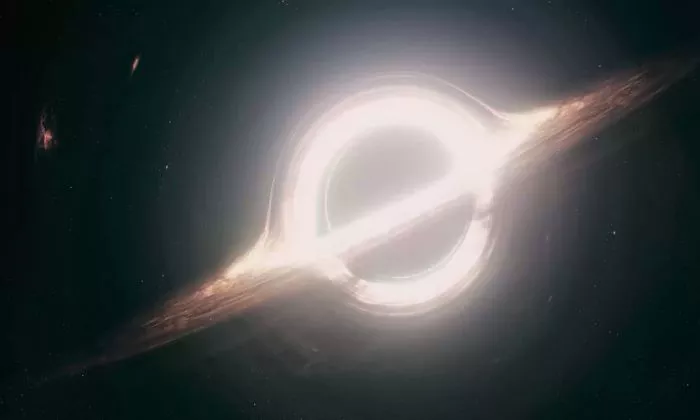Black holes are one of the most enigmatic and fascinating phenomena in the universe. They are regions in space where gravitational forces are so intense that nothing, not even light, can escape. The concept of black holes has captured the imagination of scientists and the general public alike, often making appearances in science fiction, including the critically acclaimed movie Interstellar directed by Christopher Nolan. In this essay, we will delve into the nature of black holes, discussing their properties and the portrayal of a black hole in Interstellar, evaluating its accuracy based on current scientific understanding.
Understanding Black Holes
At the heart of a black hole lies a singularity, a point of infinite density where the laws of physics as we understand them break down. Surrounding the singularity is the event horizon, the boundary beyond which nothing can return. This region is responsible for the characteristic “blackness” of black holes, as any light emitted from beyond the event horizon cannot escape its gravitational grip.
Black holes come in different sizes, ranging from stellar-mass black holes, formed from the remnants of massive stars, to supermassive black holes, which reside in the centers of galaxies and can have masses millions or even billions of times that of our Sun. The formation of black holes can occur through various processes, such as the collapse of massive stars or the mergers of smaller black holes.
Interstellar’s Representation of Black Holes
In Interstellar, Christopher Nolan and his team aimed to create a visually stunning and scientifically accurate depiction of a black hole. They collaborated closely with physicist Kip Thorne, a Nobel laureate known for his work on gravitational physics and black holes, to ensure the portrayal remained faithful to our current understanding of these cosmic entities.
The black hole depicted in Interstellar is named Gargantua, and it serves as a central plot element in the movie. Gargantua is a supermassive black hole located in a distant galaxy, and it exerts a significant gravitational influence on the surrounding space-time. The filmmakers employed cutting-edge computer-generated imagery (CGI) techniques to visualize the effects of gravitational lensing, time dilation, and the warping of space around the black hole.
One of the most striking aspects of Gargantua’s portrayal is its accretion disk, a swirling disk of hot gas and dust spiraling into the black hole. The accretion disk is illuminated by intense radiation and exhibits complex gravitational lensing effects, bending and distorting the light emitted from behind it. This creates mesmerizing visual patterns that accurately reflect the gravitational lensing phenomena predicted by Einstein’s theory of general relativity.
Another noteworthy feature of Gargantua is its depiction of time dilation. As the characters approach the black hole, they experience a dramatic slowing of time relative to those outside the gravitational influence. This effect, known as gravitational time dilation, arises due to the intense gravitational field near the event horizon. While mere minutes pass for those outside the black hole, years or even decades may elapse for those near its boundary. Interstellar portrays this concept with remarkable fidelity, immersing viewers in the mind-bending distortions of time caused by Gargantua’s immense gravitational pull.
Scientific Accuracy of Interstellar’s Black Hole
Overall, Interstellar‘s portrayal of a black hole is remarkably accurate from a scientific perspective. The filmmakers paid careful attention to the principles of general relativity and consulted with leading experts in the field to ensure the visual effects remained faithful to our current understanding of black holes and their gravitational effects.
However, it’s important to note that certain artistic liberties were taken to enhance the cinematic experience. For example, the appearance of the accretion disk and the intensity of the gravitational lensing effects may be exaggerated for dramatic effect. Additionally, the proximity of the characters to the black hole’s event horizon and the survivability of their spacecraft under such extreme conditions may stretch the boundaries of scientific plausibility.
Despite these concessions to cinematic storytelling, Interstellar succeeds in capturing the awe-inspiring grandeur and scientific intrigue of black holes. By combining state-of-the-art visual effects with a deep appreciation for the underlying physics, Christopher Nolan and his team have crafted a compelling and visually stunning portrayal of one of the most mysterious phenomena in the cosmos.
Conclusion
Black holes are enigmatic cosmic objects that challenge our understanding of the universe’s fundamental laws. In Interstellar, Christopher Nolan and his team endeavored to create a scientifically accurate representation of a black hole, consulting with experts and utilizing cutting-edge CGI techniques to bring their vision to life. The resulting portrayal, exemplified by the black hole Gargantua, is a breathtaking fusion of art and science, offering viewers a glimpse into the profound mysteries of the cosmos. While certain artistic liberties were taken for dramatic effect, Interstellar‘s depiction of a black hole remains remarkably faithful to our current understanding, serving as both a visual spectacle and a testament to humanity’s insatiable curiosity about the universe.
Related Topics:
The Wormhole in “Interstellar” – Is it possible?
Is it possible for “Interstellar” to happen?
“Interstellar”: A Cinematic Odyssey through Space, Time, and Humanity’s Soul

